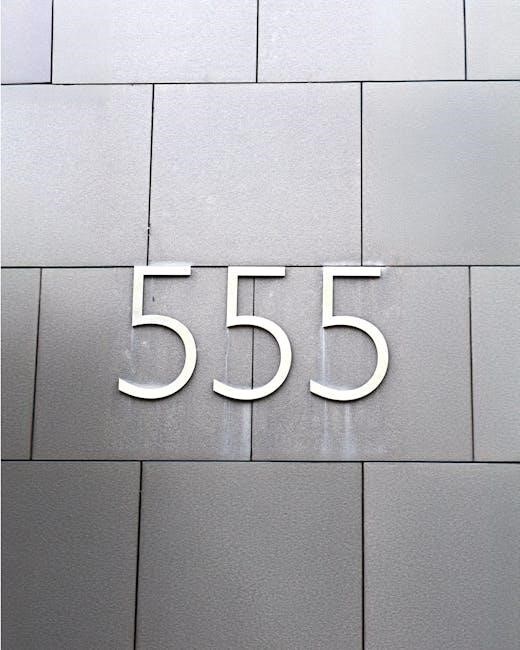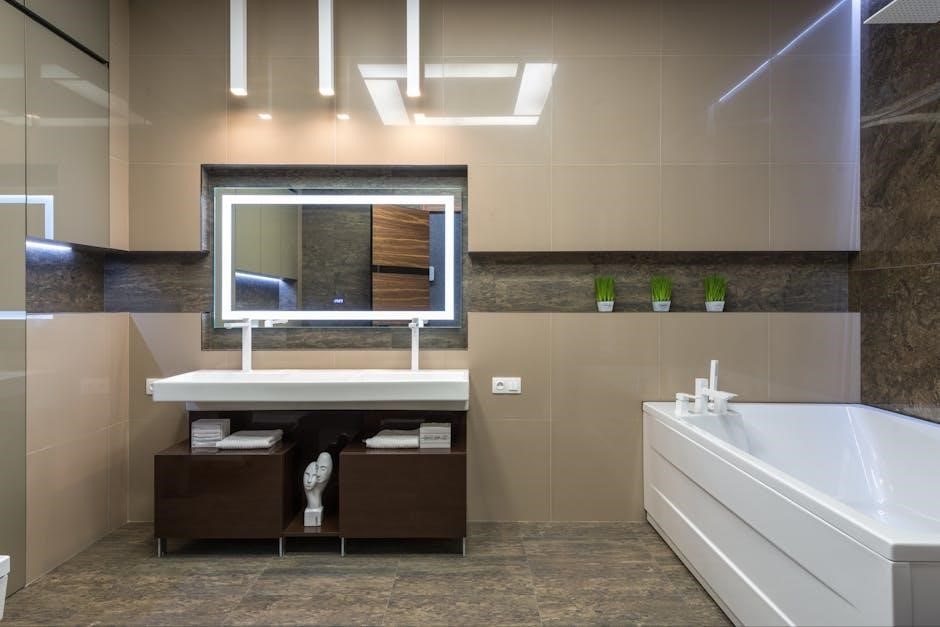ANSI tile installation standards provide guidelines for ceramic tile installation, ensuring quality, safety, and durability. These voluntary standards cover materials, methods, and testing for professional installers.
Overview of ANSI Standards for Ceramic Tile Installation
The ANSI standards for ceramic tile installation provide comprehensive guidelines for ensuring high-quality, durable, and safe installations. These voluntary standards, developed by the Tile Council of North America (TCNA), cover various aspects of tile installation, including materials, methods, and testing. Key documents such as ANSI A108, A118, and A136.1 define requirements for materials, installation practices, and slip resistance. They also outline test methods for physical properties like warpage and slip resistance, ensuring tiles meet specific performance criteria. These standards apply to all types of ceramic and porcelain tiles, including mosaic, quarry, and large-format tiles. By adhering to ANSI standards, installers can achieve professional results, minimize defects, and ensure long-lasting, visually appealing tile installations. These guidelines are updated periodically to reflect industry advancements and best practices.
Importance of Adhering to ANSI Standards in Tile Installation
Adhering to ANSI standards in tile installation is crucial for ensuring durability, safety, and aesthetic appeal. These standards provide clear guidelines for materials, methods, and testing, helping installers avoid common mistakes that lead to costly repairs. Compliance reduces the risk of tile failure, such as cracking or detachment, and ensures installations meet expectations for performance. ANSI standards also address safety concerns, like slip resistance, which is critical in high-traffic or wet areas. By following these guidelines, installers can maintain professional credibility, satisfy warranty requirements, and deliver high-quality results. Ultimately, ANSI standards serve as a foundation for achieving long-lasting and visually appealing tile installations that meet industry and client expectations.
Key Documents: ANSI A108, A118, and A136.1
The ANSI standards for tile installation are outlined in three essential documents: A108, A118, and A136.1. ANSI A108 provides general requirements for installing ceramic tile, including preparation, materials, and methods. ANSI A118 focuses on specifications for tile installation materials, such as adhesives, grouts, and mortars. ANSI A136.1 establishes testing methods for slip resistance, ensuring tiles meet safety standards. Together, these documents form a comprehensive guide for installers, manufacturers, and specifiers. They are regularly updated to reflect industry advancements and best practices. These standards are available as PDFs through the ANSI webstore, serving as indispensable resources for professionals seeking to ensure compliance and quality in tile installations.
Key ANSI Standards for Tile Installation
ANSI A108, A118, and A136.1 provide essential guidelines for ceramic tile installation, ensuring durability, safety, and compliance with industry best practices. These standards cover materials, methods, and testing.
ANSI A108: General Requirements for Tile Installation
ANSI A108 outlines general requirements and recommendations for installing ceramic tile, including surface preparation, materials, and installation methods. It covers bond coats, substrates, and setting materials, ensuring compatibility and durability. The standard addresses various installation techniques, such as thin-set and thick-set methods, and provides guidelines for movement joints to accommodate expansion and contraction. Additionally, it includes requirements for grouting, caulking, and finishing to ensure a professional and long-lasting installation. Compliance with ANSI A108 helps reduce the risk of installation failures and ensures adherence to industry best practices, complementing other standards like ANSI A118 and A136.1 for a comprehensive approach to tile installation.
ANSI A118: Specifications for Tile Installation Materials
ANSI A118 provides detailed specifications for materials used in tile installation, including adhesives, grouts, and mortars. It establishes requirements for bond strength, durability, and performance under various conditions. The standard covers materials for thin-set, thick-set, and epoxy installations, ensuring compatibility with different tile types and substrates. Testing methods are outlined to verify material performance, such as shear bond strength and water resistance. Compliance with ANSI A118 ensures that materials meet industry standards for quality and reliability, reducing the risk of installation failures. Proper material selection, as per A118, is critical for achieving a durable and aesthetically pleasing tile installation, aligning with other ANSI standards for a cohesive approach.
ANSI A136.1: Slip Resistance Requirements for Ceramic Tile
ANSI A136.1 establishes requirements for slip resistance of ceramic tile, ensuring safety in various applications. It provides test methods, such as the dynamic coefficient of friction, to measure slip resistance under different conditions. The standard classifies tiles based on their slip resistance performance, helping specifiers choose appropriate products for specific uses. Compliance with A136.1 ensures tiles meet minimum safety standards, reducing the risk of accidents in both residential and commercial settings. Regular testing and certification are essential to verify tile performance, making this standard a critical reference for manufacturers, architects, and installers seeking to ensure safe and durable tile installations.

Materials and Specifications
ANSI standards detail requirements for ceramic tile materials, including physical properties, grading, and testing. Specifications cover mortars, adhesives, and grouts, ensuring compatibility and durability in installations.
Ceramic Tile Types: Mosaic, Quarry, Porcelain, and More
Ceramic tiles vary widely, ranging from mosaic, quarry, and porcelain to glass and natural stone. ANSI standards classify these types based on composition, use, and physical properties. Mosaic tiles are small, durable, and suitable for intricate designs, while quarry tiles are dense and ideal for heavy-duty applications. Porcelain tiles, known for their low water absorption, are versatile and popular for both walls and floors. Each type must meet specific ANSI requirements for strength, slip resistance, and durability, ensuring they perform well in their intended environments. These classifications help installers and specifiers choose the right tile for projects, adhering to industry standards for quality and safety.
Physical Properties and Grading of Ceramic Tile
Ceramic tiles are evaluated based on physical properties such as water absorption, breaking strength, and slip resistance. ANSI standards classify tiles into grades based on factors like size, shape, and surface quality. Water absorption is a critical property, with lower absorption indicating higher durability. Breaking strength, measured by modulus of rupture, determines a tile’s ability to withstand foot traffic and heavy loads. Slip resistance is tested using methods like the dynamic coefficient of friction (DCOF) rating. Grading ensures tiles meet specific performance criteria, helping installers and specifiers choose appropriate products for various applications. These standards ensure consistent quality and reliability in ceramic tile installations.
Mortars, Adhesives, and Grouts: ANSI A118.4 and A118.15
ANSI A118.4 and A118.15 provide specifications for mortars, adhesives, and grouts used in ceramic tile installations. A118.4 focuses on polymer-modified thin-set mortars, ensuring they meet requirements for bond strength, flexibility, and durability. These mortars are suitable for various substrates and applications, including areas subject to vibration. A118.15 addresses cement grouts, defining properties like flowability, water retention, and stain resistance. It also covers types, such as sanded and unsanded grouts, and their suitability for joint widths. Proper selection and application of these materials are critical for ensuring tile installations are durable and compliant with industry standards. These standards guide installers in choosing the right products for specific projects.

Installation Methods and Guidelines
ANSI standards outline best practices for tile installation, ensuring durability and aesthetics. Guidelines cover substrate preparation, mortar application, and grouting techniques for various tile types and settings.
Thin-Set Ceramic Tile and Dimension Stone Installation (A118.10)
ANSI A118.10 provides detailed guidelines for thin-set ceramic tile and dimension stone installations. It specifies requirements for bonding agents, substrates, and installation materials. The standard emphasizes proper substrate preparation, including surface cleanliness and structural integrity. Thin-set mortars must meet specified bond strength and flexibility criteria. Installation procedures include spreading adhesive evenly, aligning tiles, and ensuring proper grout joint widths. A118.10 also addresses movement joints to accommodate thermal and structural expansions. Compliance ensures long-term durability, preventing cracks and detachment. Adherence to this standard is critical for achieving professional, high-quality installations in residential and commercial settings. Proper curing times and grouting techniques are also outlined to ensure optimal results.
Waterproof Membranes for Thin-Set Installations (A118.10)
ANSI A118.10 includes guidelines for waterproof membranes in thin-set ceramic tile and dimension stone installations. These membranes are critical in areas exposed to water, such as bathrooms and kitchens. The standard specifies requirements for membrane materials, application methods, and compatibility with thin-set mortars. It emphasizes proper surface preparation and ensures the membrane’s integrity to prevent water infiltration. Testing procedures are outlined to verify membrane performance, including bond strength and water impermeability. Compliance with A118.10 ensures reliable protection against moisture damage, enhancing the durability and longevity of tile installations. Proper installation of waterproof membranes is essential for maintaining structural integrity and preventing costly repairs.
Dry-Set Cement Mortar Specifications (A118.11)
ANSI A118.11 outlines specifications for dry-set cement mortars used in ceramic tile and dimension stone installations. These mortars are designed for bonding tile to surfaces without the need for excess water, ensuring a strong, durable bond. The standard details requirements for mortar materials, mixing procedures, and application methods. It also covers testing methods to ensure mortar performance, including compressive strength and bond strength. A118.11 emphasizes proper surface preparation and mortar consistency to achieve optimal results. Compliance with this standard ensures reliable adhesion and long-lasting installations. Dry-set mortars are widely used in residential and commercial projects, offering a cost-effective and efficient solution for tile installation.
Testing and Quality Assurance
Testing ensures materials and installations meet ANSI standards, verifying performance, safety, and durability through rigorous protocols and quality assurance processes.
Test Methods for Ceramic Tile and Installation Materials
ANSI standards outline specific test methods to evaluate the performance and quality of ceramic tile and installation materials. These tests assess properties like tensile strength, shear strength, and slip resistance. Materials such as adhesives, grouts, and membranes are tested for durability, bond strength, and moisture resistance. Ceramic tiles are evaluated for factors like warpage, water absorption, and breaking strength. Standardized testing ensures compliance with specifications and guarantees reliable performance in various applications. Detailed test procedures are outlined in ANSI documents, providing clear guidelines for manufacturers, installers, and inspectors. Adhering to these methods ensures installations meet safety, durability, and aesthetic requirements. These tests are critical for maintaining industry standards and quality assurance.
Warpage Measurement: ASTM C485 and ANSI A137.1

Warpage measurement is critical for ensuring ceramic tiles meet flatness requirements. ASTM C485 provides a test method to measure warpage by evaluating the deviation of a tile’s surface from a flat plane. ANSI A137.1 specifies allowable warpage limits for ceramic tile, ensuring tiles are suitable for installation. These standards help determine if tiles will lie flat and align properly. Excessive warpage can lead to installation issues, such as uneven surfaces or poor grout joints. By adhering to these guidelines, manufacturers and installers can ensure tiles meet quality and performance expectations, reducing the risk of post-installation problems. These measurements are essential for maintaining high standards in tile installation.
Slip Resistance Testing and Classification
Slip resistance testing is essential for ensuring ceramic tiles are safe for various applications. ANSI A137.1 provides guidelines for measuring the dynamic coefficient of friction (DCOF) under wet conditions. Tiles are classified based on their DCOF values, with higher values indicating better slip resistance. For example, a DCOF of 0.42 or higher is often required for areas exposed to water. Testing methods include the DCOF AcuTest and the pendulum test, while the wet ramp test is another recognized method. Proper classification ensures tiles meet safety standards for commercial and residential use. Adhering to these standards helps prevent accidents and ensures compliance with building codes. Regular testing is crucial for maintaining quality and safety in tile installations.

Industry Best Practices
Adhering to ANSI standards and TCNA guidelines ensures professional tile installation. Key practices include precise layout planning, maintaining uniform grout joints, and using appropriate materials. Personal protective equipment and ongoing installer training are also essential for safety and quality outcomes.
Layout Guidelines for Ceramic Tile Installation
Proper layout planning ensures a visually appealing and functional tile installation. Begin by measuring the area accurately and marking the center point. Use chalk lines to define the grid, ensuring symmetry. Start tile installation from the center, working outward to maintain balance. Consider grout joint spacing and tile size to avoid uneven cuts. Align tiles with walls or reference lines, using spacers for consistent gaps. Plan for movement joints in large areas to prevent cracking. Verify layout alignment before applying adhesives. Adjustments should be made during the dry layout phase to achieve the desired aesthetic and functional outcome. This step is critical for a professional finish.
Workmanship Requirements: Straight Joints and Even Widths
ANSI standards emphasize the importance of precise workmanship to ensure durability and aesthetics. Tile joints must be straight and evenly spaced, typically between 1/8 inch and 1/2 inch, depending on the tile type. Grout lines should align uniformly, avoiding uneven spacing that can lead to a visually unappealing result. Installers must use tools like laser levels or chalk lines to maintain straightness. Proper spacing ensures structural integrity and prevents cracking. Adhering to these guidelines guarantees a professional finish and compliance with industry standards. Even grout widths also contribute to a balanced appearance, enhancing the overall quality of the installation. Precision in alignment and spacing is critical for meeting ANSI requirements.
Personal Protective Equipment for Installers
ANSI standards recommend that installers use appropriate personal protective equipment (PPE) to ensure safety during tile installation. Safety glasses or goggles are essential to protect eyes from dust and debris generated by cutting or grinding. Dust masks or respirators should be worn when handling materials that release airborne particles. Gloves prevent cuts and abrasions from sharp tile edges and adhesives. Steel-toe boots or sturdy footwear is recommended to protect feet from heavy tools or falling tiles. Hearing protection, such as earplugs, is advised when using loud power tools. Long sleeves and pants can shield skin from irritation caused by adhesives or grout. A hard hat may be required on construction sites. Ensuring proper PPE use minimizes risks and promotes a safe working environment.
Specialized Installations
Specialized installations, such as large-format tiles and dimension stone, require unique considerations for substrates, materials, and techniques. ANSI standards provide detailed guidelines to ensure durability and aesthetics.

Large Format Tile Installation: Challenges and Solutions
Large format tile installation presents unique challenges, including handling heavy tiles, managing lippage, and ensuring proper substrate preparation. ANSI standards address these issues by specifying minimum requirements for bond strength, substrate flatness, and grouting techniques. For example, ANSI A108.10 recommends the use of large-format tile mortars (A118.15) to accommodate the higher weight and stress of these tiles. Additionally, specialized tools, such as laser-guided leveling systems, are essential for maintaining uniformity and preventing unevenness. Adherence to these guidelines ensures a stable and visually appealing installation, meeting both functional and aesthetic expectations in commercial and high-end residential projects.
Installation of Tile on Plywood Surfaces (A118.11)
Installing tile on plywood surfaces requires careful preparation and adherence to ANSI A118.11 standards. The plywood must be structurally sound, dry, and free of any debris or old adhesives. A minimum of 1.5 inches of plywood is recommended for residential installations, while commercial settings may require thicker substrates. A moisture-resistant barrier should be applied to prevent warping or delamination. ANSI A118.11 specifies the use of modified thin-set mortars for bonding tile to plywood. Proper fastening of the plywood to the framing is essential to prevent movement. Allow the adhesive to cure fully before grouting to ensure a durable and long-lasting installation. This standard ensures compatibility between tile and plywood, avoiding potential failures.
Dimension Stone Installation: Best Practices
Dimension stone installation requires precise planning and execution to ensure durability and aesthetics. ANSI standards emphasize proper substrate preparation, ensuring it is level, plumb, and structurally sound. The surface must be clean, dry, and free of contaminants. A compatible mortar, as specified in ANSI A118, should be used for bonding, with particular attention to flexural strength. Expansion joints are critical to accommodate thermal and structural movements. Stones should be placed with uniform joints and leveled meticulously. For larger stones, mechanical anchoring may be necessary. Grouting must be completed with a material that matches the stone’s porosity, and curing should follow manufacturer guidelines. Regular maintenance and optional sealing can enhance longevity and appearance. Adhering to these practices ensures a professional and long-lasting dimension stone installation.

Updates and Revisions in ANSI Standards
ANSI tile installation standards are updated regularly to reflect advancements in materials and techniques. The 2024 updates include new guidelines for large-format tiles and improved waterproofing methods.

Recent Changes in ANSI A108/A118/A136.1:2024
The 2024 updates to ANSI A108, A118, and A136.1 introduce enhanced guidelines for substrate preparation, tile layout, and material performance. A108 now includes stricter requirements for surface flatness and alignment, ensuring smoother installations. A118 focuses on new adhesive materials, improving bond strength and moisture resistance. A136.1 updates slip resistance testing methods, aligning with international safety standards. Additionally, the revisions incorporate sustainability practices, such as recycled materials in tile production. These changes aim to address modern installation challenges, including large-format tiles and high-moisture areas. Installers must adhere to these updates to ensure compliance and maintain quality. The updated standards are available in the ANSI tile installation standards PDF for reference.
Evolution of ANSI Standards for Ceramic Tile
The ANSI standards for ceramic tile installation have evolved significantly over the decades, reflecting advancements in materials, techniques, and industry needs. Initially focused on basic installation practices, the standards now encompass detailed requirements for substrates, adhesives, and grouting methods. Key updates include improved guidelines for large-format tiles, enhanced slip resistance testing, and updated material specifications. Sustainability has also become a focus, with provisions for eco-friendly materials and waste reduction. These revisions ensure installations meet modern performance and safety expectations. The ANSI tile installation standards PDF provides a comprehensive overview of these developments, serving as a vital resource for professionals. This evolution underscores the commitment to quality and innovation in the ceramic tile industry.
Impact of Updated Standards on Tile Installers
Updated ANSI standards significantly influence tile installers by requiring adherence to new methodologies and material specifications. These changes often mandate additional training to ensure compliance, particularly with advancements in products like adhesives and grouts. Installers must familiarize themselves with revised guidelines for substrate preparation, tile placement, and grouting techniques. Non-compliance can lead to project failures or legal issues. Staying updated ensures higher quality installations, enhances professionalism, and builds customer trust. The ANSI tile installation standards PDF provides detailed insights, helping installers adapt to these changes and maintain industry competitiveness. Regular updates also prompt invest

Resources and References
Key resources include the TCNA Handbook, ANSI standards PDFs, and ISO guidelines. Visit the ANSI webstore for official documents and updates on ceramic tile installation standards.
TCNA Handbook: A Comprehensive Guide for Installers
The TCNA Handbook is a definitive resource for tile installers, offering detailed guidelines aligned with ANSI standards. It covers installation methods, materials, and best practices, ensuring compliance with industry norms. Published by the Tile Council of North America, it provides technical specifications, diagrams, and case studies for various tile applications. The handbook emphasizes proper substrate preparation, mortar applications, and grouting techniques. It also includes sections on safety, tools, and troubleshooting common installation issues. Widely regarded as an essential tool, the TCNA Handbook is available in print and digital formats, accessible via the TCNA website. It complements ANSI standards, making it indispensable for professionals seeking to deliver high-quality, compliant installations.

Where to Find ANSI Standards: Webstore and PDFs
ANSI tile installation standards are readily available through the official ANSI webstore and other authorized distributors. The ANSI webstore offers PDF versions of key documents like A108, A118, and A136.1, which are essential for tile installers. Additionally, the Tile Council of North America (TCNA) publishes and distributes these standards, providing easy access to the latest editions. Many standards are also available through online retailers and professional organizations. When searching, use specific terms like “ANSI A108 PDF” or “ANSI tile installation standards” to locate the documents efficiently. Always ensure the source is reputable to guarantee compliance with current industry regulations and best practices.
ISO Standards for Ceramic Tile and Installation Materials
ISO standards provide international guidelines for ceramic tile and installation materials, complementing ANSI standards. ISO 13007 specifies requirements for adhesives, while ISO 10545 series covers test methods for tiles. These standards ensure consistency and quality in global markets. ISO 17889 focuses on grouts, and ISO 14448 addresses slip resistance. Together, these documents harmonize with ANSI standards, offering a global perspective. Installers and manufacturers benefit from understanding both ANSI and ISO standards for international projects. These documents are available through ISO’s official website and authorized distributors, often in PDF format. Adhering to ISO standards ensures compliance with global quality and safety expectations, enhancing credibility and reliability in the industry.
The ANSI tile installation standards provide comprehensive guidelines for ensuring quality, safety, and durability in ceramic tile projects. Key documents like A108, A118, and A136.1 outline requirements for materials, installation methods, and testing. These standards emphasize the importance of proper materials, such as mortars, adhesives, and grouts, to ensure long-lasting results. Additionally, they cover critical aspects like slip resistance, warpage measurement, and waterproofing. Compliance with these standards ensures installations meet industry best practices, reducing risks of failure. By following ANSI guidelines, professionals can achieve consistent, high-quality outcomes. These standards are regularly updated to reflect advancements in technology and materials, making them indispensable for tile installers and specifiers.
Why ANSI Compliance is Essential for Quality Installations
Compliance with ANSI tile installation standards is crucial for ensuring high-quality, durable, and safe ceramic tile installations. These standards provide clear guidelines for materials, methods, and best practices, reducing the risk of installation failures. By adhering to ANSI requirements, installers can avoid costly repairs and ensure customer satisfaction. Compliance also minimizes liability risks and enhances professional reputation. ANSI standards are developed by industry experts, ensuring they reflect the latest advancements in materials and techniques. Following these guidelines guarantees installations meet industry expectations and align with manufacturer warranties and building codes. Ultimately, ANSI compliance is a cornerstone of professional tile installation, ensuring long-term performance and reliability.
Final Thoughts on Adhering to ANSI Standards
Adhering to ANSI tile installation standards is a commitment to excellence, safety, and durability in every project. These guidelines ensure installations meet rigorous quality benchmarks, minimizing errors and enhancing customer satisfaction. By following ANSI standards, professionals stay aligned with the latest advancements in materials and techniques, ensuring installations are both functional and aesthetically pleasing. Compliance fosters trust and credibility, as it demonstrates a dedication to industry best practices. For tile installers, adhering to ANSI standards is not just a recommendation—it’s a pathway to professional growth and industry leadership. Ultimately, these standards serve as the foundation for achieving long-term success and satisfaction in ceramic tile installations.